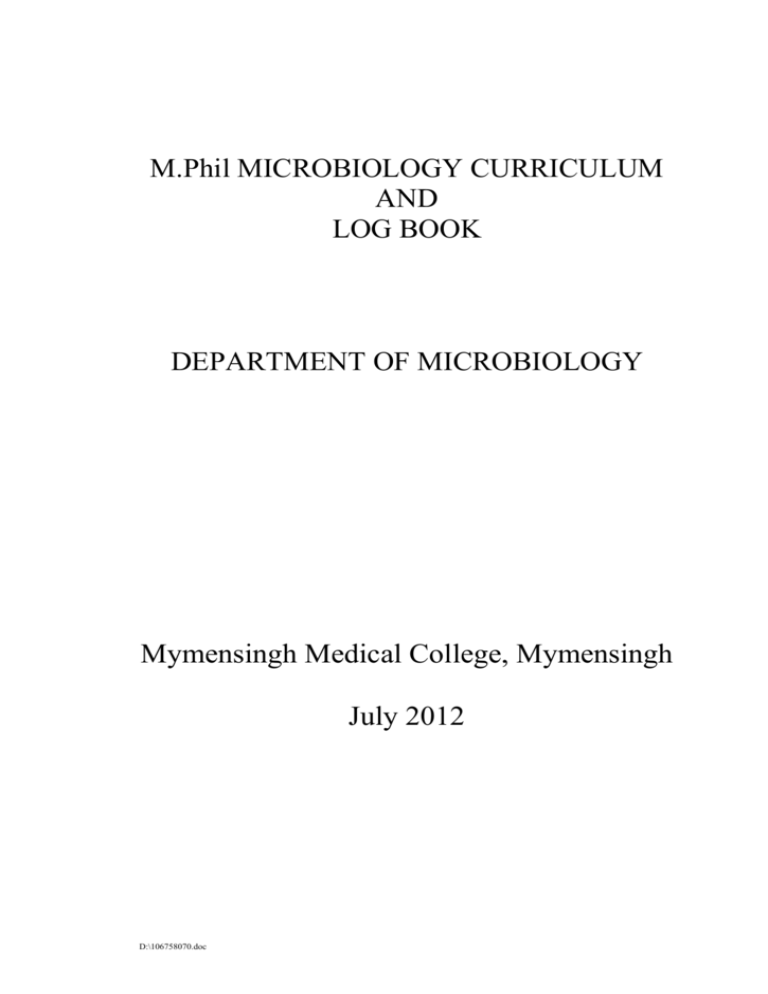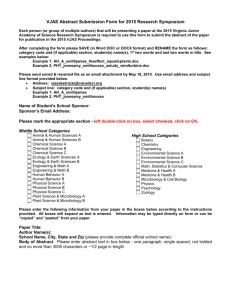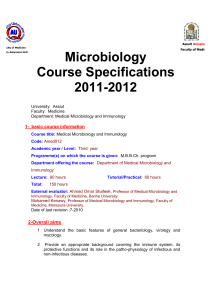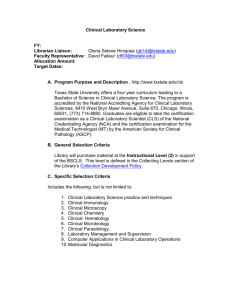MD MICROBIOLOGY CURRICULUM - Mymensingh Medical College
advertisement

M.Phil MICROBIOLOGY CURRICULUM AND LOG BOOK DEPARTMENT OF MICROBIOLOGY Mymensingh Medical College, Mymensingh July 2012 D:\106758070.doc STUDENT’S PROFILE Class roll no: University registration no: Session: July’200 Name : ............................................. Father’s Name : ............................................. Mother’s Name : ............................................. BMDC registration no:...................................... Date of Birth : ............................................. Nationality : ............................................. Address: Present with telephone: Permanent with telephone: Academic records: Degree SSC Name of the Institute Year Division HSC MBBS Service records: Name of the Office Head of Microbiology D:\106758070.doc Duration Designation Govt./Non-Govt. OVERVIEW OF THE COURESE Name of the curse Duration of the course : Master of Philosophy, Microbiology :02(Two) years Comprises Part-I, II (each 6 months) & Part-III (One year) Commencement of the course: 1st July of each year Part-I (Six months): Paper-I (Biostatistics, Biophysics & Basic Chemistry) Paper-II (General Bacteriology & Systemic Bacteriology) Paper-III (Parasitology & Mycology) Part-II (Six months): Paper-IV (Virology & Water bacteriology) Paper-V (Basic & Applied Immunology) Paper-VI (Biochemistry/ Physiology) Part-III (One year): Thesis & Thesis defense Comprehensive Viva Examination format Each paper of Part-I & II Written Practical Oral Part-III Thesis & Thesis defense Comprehensive Viva D:\106758070.doc Total Marks 100 50 50 Pass Marks 60 30 30 200 100 120 60 M.Phil (Microbiology) Syllabus PART-I: Paper –I (Biostatistics, Biophysics & Basic chemistry) Biostatistics 1. Introduction to research, research strategies and design 2. Concept regarding major categories of medical research: a) experimental studies b) descriptive epidemiological studies and c) clinical trials (aspects more relate to basic sciences research shall be emphasized) 3. Relevant methodological details of collection and interpretation of data a) sampling techniques and sample size b) questionnaire design c) preparation of data sheet d) bias and confounding e) basic risk measurements 4. Tests of significance of differences, association and causation 5. Ethical aspects of medical research 6. Preparation of a research proposal (protocol) 7. Writing up of thesis-details of every aspect (from title to appendices) of the thesis including presentation of results (descriptive statistics) in tables, graphs, charts, photographs, photomicrographs, etc. 8. Writing a research paper 9. Presentation of a research paper: a) oral presentation b) poster presentation Teaching methodology 1. Basics of learning and teaching, curriculum planning and quality assurance in the Institution. 2. Teaching methods: a) basic planning b) giving lectures c) small group teaching d) taking practical classes. 3. Teaching resources (materials): a) audio-visual aids and their uses. 4. Assessment of student performance: a) principles of assessment b) planning of written examinations( including setting of various types of written questions and their comparisons) c) planning of oral and practical examinations (including designing OSPE stations) NB: Teaching assignments shall be given to the students and shall be evaluated by the teachers. Paper – II General Bacteriology Theory: Bacterial Structure, Nomenclature, Growth and Nutrition, Genetic and Metabolism. Classification, Media and Staining. Sterilization & Disinfection, Host parasite Relationship, Genetics, Normal floras & Opportunistic Bacteria, Bacterial Pathogenesis,Antimicrobial agents and Drug resistance, Milk, food & Water Bacteriology. Laboratory design and Management and Laboratory safety, Safe disposal of laboratory products. Practical: Laboratory safety, Quality assurance, Safe disposal of laboratory products, Specimen collection and transportation, Laboratory procedures, Record keeping, Preparation of Media, Preparation of Staining material, Staining, Microscopy of Stained smear, Preservation of culture and other sample, Preparation of Antimicrobial disc, Practice of sterilization and disinfection. D:\106758070.doc Systemic Bacteriology Theory: Cocci ( Staphylococcous, Streptococcous, Neisseria), Haemophilus, Corynebacteria, Mycobacteria, Enterobacteriaceae, Vibrioniaceae, Pseudomoniaeae, Plesiomonas Aeromonas, Listeria, Erysipelothrix, Actinomyces, Acinatobacter, Nocardia, Yersinia, Pasturella, Bordetella, Francisella, Brucella, Anaerobic (Non sporing) bacteria, Sporebearing bacteria,Helicobacter, Campylobacter, Spirocheate, Campylobacter, Rickettisia, Chlamydia, Mycoplasma, Legionellae, Gardenella, Actinobacillum. Outbreak investigation: Sample transportation, Isolation, Identification and reporting, Diarrheal pathogens Practical: 1. 1. 2. 3. 4. Isolation and Identification of unknown Bacteria Serological procedures in Bacteriology Biochemical procedures in Bacteriology Antimicrobial susceptibility Performance testing and IQC Paper –III (Parasitology & Mycology) Parasitology Theory: Introduction, Classification of Parasite Protozoology: Amoebae, Flagellates, Ciliata, Sporozoa Helminthology: Cystode, Trematode, Nematode Practical: 1. 2. 3. 4. 5. Examination of urine Examination of Stool Examination of Blood Examination of Bone marrow Exam of Aspirate : Liver Spleen Lymphnode 6. Examination of adult parasite Mycology Theory: Structure, Classification, Anti fungal drugs M.furfur, Dermatophytes, Candida. Deep/Systemic fungus Opportunistic fungus Practical 1) Specimen collection 2) Microscopy (Wet film and Stained microscopy) 3) Culture and Serology 4) Reporting D:\106758070.doc PART-II Paper-IV (Virology) Theory: General Virology: Nomenclature, Properties and structure of virus, Viral Pathogenesis, Antiviral Agents, Viral vaccine Systemic virology: Herpes viruses (H. simplex, H. Zooster, Cyto-megalo Virus, Epstein Bar Virus, HSV- 6) Hepatitis viruses, Virus Associated with diarrhea, Rota virus, Corona virus, Adeno virus Papilloma virus, Respiratory viruses (Influenza and Para influenza virueses, Respiratory Synsytial Virus, Adeno virus, Rhino virus) Corona viruses, Measles, Rubella, Mumps Entero viruses (Polio virus), Pox virus, Viral Hemorrhage fever, Rhabdo virus, Dengue Virus, Retro viruses, HTLVs, HIVs, Prion disease, Oncogenic viruses, Viral oncogenesis. Milk, Food and Water bacteriology Practical: 1) Specimen collection and transport 2) Laboratory safety 3) Laboratory diagnosis of viral diseases 4) Tissue culture and other laboratory Techniques 5) Serological method in virology 6) Testing water/Milk Paper –V (Basic & Applied Immunology) Theory: Structure & organization of Immune system, Cells of Immune system. Antigen, Immunogen, Hapten. Mediators (Complements, Cytokines and Immunoglobulin), MHC, Immunity and Immune response. Tolerance, Hypersensitivity, Transplantation Rejection, Auto immunity, Tumor immunology Immunity against Bacteria,Virus, Parasite, Fungus, Immunodeficiency, Autoimmune diseases,Vaccines. Practical: Haemolysin preparation, Titration ( Complement, Haemolysin), CFT, Agglutination, Precipitation, IFAT, ELISA, Electrophoresis, Chromatography, PCR, Western Blot, Chemiluminescence, Cell separation(Flow cytometry), HLA typing. Paper VI (Biochemistry/ Pathology) FINAL PART: A. Thesis & Thesis defense B. Comprehensive VIVA D:\106758070.doc Comprehensive VIVA will cover all areas of Bacteriology, Parasitology and Mycology, Immunology & Virology. D:\106758070.doc Bacteriology Pactrical Duration in Week One Section Two one One Two Two Two D:\106758070.doc Orientation in the department and Reception: Patient dealing, sample collection, processing, recording & reporting system Aseptic practices in laboratory and safety precautions Collection/transport of specimens for microbiological investigations Sterilization Section, Lab safety, waste disposal Introduction to BSL -1& 2 Operation of autoclave, hot air oven, distillation plant, filter, Refrigerated centrifuge, Microwave oven, Micropipette, Water bath, Heating block Microscopy (Light, DGI, Phase contrast, Imm FI Microscopy: Maintenance) Preparation of stains viz. Gram, Ziehl Neelsen , Albert’s, capsules, spores, (ZN) etc. Preparation, examination & interpretation of direct smears from clinical specimens ( stool, urine, Pus, HVS, Sputum, U/S, CSF) Introduction to Plating of clinical specimens on media for isolation, purification, identification and quantitation purposes. Preparation of media like Nutrient Broth/ agar, Blood Agar, Macconkey agar, Robertson’s cooked meat broth, Lowenstein Jhensen . Preparation of reagents -oxidase, Kovac Sugars, Kligler iron agar, etc. Quality control of media, reagents etc. Bleeding techniques of sheep and preparation of BA and Chocolate agar media. Study of Colony Morphology Of Common Bacteria- Staphyloccus, Strepcococcus, Esch Coli, Date Level of Participation A B C A B C A B C A B C A B C A B C A B C Teachers comment Duration in Week One Section Date Salmonella, Shigella, Pseudomonas, Proteus, Klebsiella, Enterococci, Campylobacter, Mycobacterium (Using control strains) Tests for Motility, hanging drop, DGI, Soft agar, catalase, oxidase, Coagulase, (slide & tube) Sugar fermentation, TSI, Citrate, Indole, Hippurate etc Special culture technique including anaerobiosis, Microaerophilic etc Identification Of Bacteria Of Medica1 Importance Upto Species Level including serotyping. Two Two One Two One One Disposal of contaminated materials like cultures Disposal of infectious waste Maintenance & preservation of bacterial cultures Two Test of tap water for bacteria and Plating of clinical specimens on media for isolation, purification, identification and quantitation purposes. Quantitative analysis of urine by pour plate method and semi quantitative analysis by standard loop tests for finding significant bacteriuria Culture of Blood, Sputum, CSF, Stool etc. colony count Two Efficacy of sterility by autoclaving , Hot air oven and filtration Two Bacteriological study of Mobiles, key boards, table top. Introduction techniques- D:\106758070.doc Level of Participation to Molecular A B C A B C A B C A B C A B C A B C Teachers comment Duration in Week Section Date Level of Participation Teachers comment Date Level of Participation Teachers comment DNA/ RNA extraction from clinical specimen, Bacterial colony Different type of Electrophoresis for detection DNA/RNA Amplification of DNA Documentation of amplicon. Parasitology Duration in Week Two Section one One Egg counting techniques for helminths by Mcmaster technique Preservation of parasites-mounting, fixing, staining etc. Examination of blood for protozoa and helminths by wet mount, thick and thin stained smears Examination of blood for microfilariae including concentration techniques Culture media Leishmania donovani in NNN medium Culture of Helminths by Haradimori technique Preparation of stains- Giemsa, Leishman, Methylene blue, Fields stain, Iron hematoxylene, etc A B C Aspirate/Biopsy from Bone marrow, /liver, spleen, L.node, , skin Examination of faeces for parasite ova and cysts etc. by direct Microscopy and concentration methods (salt floatation and formolether methods) D:\106758070.doc Collection and transport of specimens for diagnosis of parasitic diseases Stool- for Protozoa and Helminths Blood for MP, Filaria, Kala-azar, Trypanos,oa, A B C Mycology Duration in Week Two Section one One Date Level of Participation Teachers comment A B C Collection and transport of specimens for diagnosis of Fungal diseases Collection technique for dermatophytes from Skin, nail and Hair Processing of samples for microscopy and culture o Direct examination of specimens by KOH, Gram’s, Acid fast, Giemsa, Lactophenol cotton blue & special fungal stains Isolation and identification of medically important fungi & common laboratory contaminants Comparison of SDA and Special fungal media like Dermatophyte test media alike Germ tube test for Candida Special fungal culture techniques e.g. Plates culture, Slide culture Special techniques like hair baiting, hair perforation, paraffin baiting and A B C Virology Duration in Week one Two Section Preparation of clinical specimens for isolation of viruses Collection & transport of specimens Serological tests -ELISA for HBsAg, HBsAB, HBeAg, HCV, HEV ICT for HIV, HCV , HEV etc Molecular techniques in virology One D:\106758070.doc Polyacrylamide Gel electrophoresis for Rota virus Date Level of Participation A B C A B C Teachers comment Duration in Week Section Date Level of Participation Teachers comment Date Level of Participation Teachers comment Introduction to cell/ Tissue culture Preparation of glassware for tissue cultures (washing, sterilisation). Preparation of buffers like PBS, Hank’s, TBE Water Bacteriology Duration in Week one Section Examination of Water – o Sampling – Tap water, River water, Tube well water o Counting indicator bacteria- A B C Fecal Esch coli Two One D:\106758070.doc o Filtration method o Multiple tube - MPN Examination of Milk – o Methylene blue test o Phosphatase test Food Bacterilogy A B C Book List Bacteriology 1. Medical Microbiology,LANGE 2. Mandell, Douglas, and Bennett's Principles and Practice of Infectious Diseases 3. Medical Microbiology Patrick. M. Murry 4. District Laboratory Practice in Tropical Countries; Part 1 and Part II; Monica Cd Cheesbrough, Cambridge university press. Reprint 2007 5. Mackie & McCartney ; Practical Medical Microbiology, Fourteenth Edition, Churcill Livingstone Immunology 1. Medical Immunology, LANGE 2. Immunology ; Richad A. Goldsby, Janis Kuby 3. Roitt’s Essential Immunology Parasitology 1. K. D. Chatterjee 2. Medical Parasitology basic and clinical. Mycology Medically Important Fungi, 4th Edition, Davise H Larone, ASM press, Washington DC Human Mycology by Dr. Ahmed Abu Saleh 1. 2. B. ASSIGNMENT Date Topic of Assignment 1 2 3 D:\106758070.doc Duration Date of Submission Score Signature Coordinator C. Journal club Registrar No. 1 Topics Date Coordinator Date Coordinator 2 3 D. Seminar Registrar No. 1 Topics 2 This is to certify that Dr.............................................................. having the BSMMU egistration no................................ are correct and eligible/not eligible to appear in the Part-I examination. Signature of the Course Co-ordinator: D:\106758070.doc Name of the Institute: Head D:\106758070.doc of the department: B. ASSIGNMENT Date Topic of Assignment Duration Date of Submission Score 1 2 3 C. Journal club Registrar No. Topics 1 Date Coordinator 2 3 4 5. 6. D. Seminar Registrar No. 1 Topics 2 3 4. 5 6 D:\106758070.doc Date Coordinator Signature Coordinator This is to certify that Dr.............................................................. having the Dhaka University registration no................................ are correct and eligible/not eligible to appear in the Part-II examination. Signature of the Course Co-ordinator: Name of the Institute: Head of the department: D:\106758070.doc Certificate: Area of activity Attendance Performance Signature Attention Laboratory skill Communication skill Journal presentation Seminar presentation Research skill Total Remarks by Head: Assignments 1. Discovery of vaccine is a mile stone in the Medical science. 2. Discovery of solid media is breakthrough in the filed of bacteriologyDiscuss 3. Common bacterial infections in Bangladesh with their prevalence in BD and other parts of world. 4. Common parasitic infections in Bangladesh with their prevalence in BD and other parts of world. 5. Common fungal infections in Bangladesh with their prevalence prevalence in BD and other parts of world. 6. 7. You have been called on to prevent outbreaks of staphylococcal scalded skin syndrome in the nursery of a hospital where an MRSA strain of S. aureus has been isolated. Explain what this organisms is, your main concerns and what procedures you would establish to address them 2. Explain the historical world impact made by epidemic typhus, discussing the disease’s mode of transmission, symptoms and disease progression. Describe D:\106758070.doc how this disease was finally brought under control, explaining current methods of treatment 3. Conduct an on-line search for emerging protozoan pathogens. Identify five of these species and make notes of the sources of infection and diseases caused 5. All three of the living microbial kingdoms, bacteria, fungi and protozoa coexist on our planet. If a global catastrophe were to occur, and only ONE of these could be preserved, which would you choose? 6. A flask of water is inoculated in BA media then heated in hot air oven for at 180 0C for 10 min, 30 min, and 60 min and then inoculated in BA and incubated at 37 0 C? Interpret your findings. 7. A flask of water is inoculated in BA media then heated in Autoclave for 50 min, 10 min, and 30 min and then inoculated in BA and incubated at 37 0 C? Interpret your findings. 8. Most important in 20th and 21st century in medical microbiology. 9. Isolate from Microbes from mobiles used by officers and staff of Microbiology, MMC. 10. Re-emergence of tuberculosis worldwide: reasons and approaches for a solution. 11. Occasional spread of polio despite universal vaccination; reasons and approaches towards a solution. D:\106758070.doc




